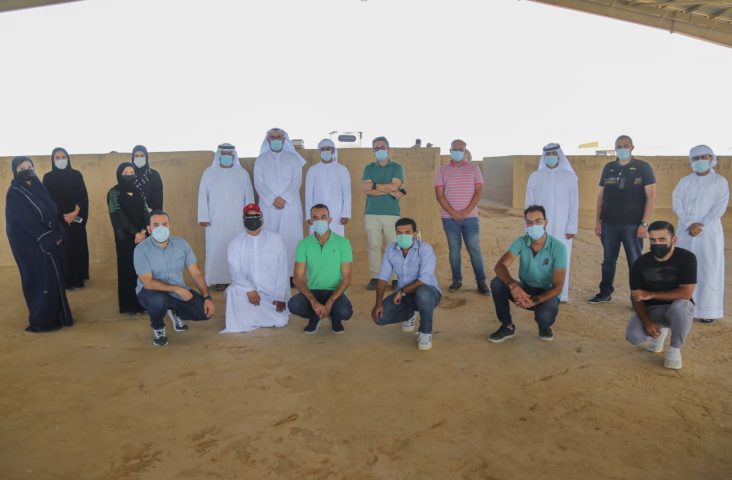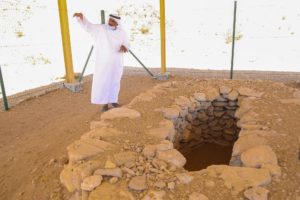Sharjah Archaeology Authority Celebrates The International Archaeology Day

The Sharjah Archaeology Authority recently organized a largescale program to mark the annual International Archaeological Day, on 17th October, which included field visits to several archaeological sites and media tours of Jebel Buhais and Mleiha. The program also included a virtual lecture delivered via Zoom, presented by Eisa Yousif, Director of the Department Archaeology at the Sharjah Archaeology Authority, entitled “The Pioneering Role of Archaeological Findings in the Emirate of Sharjah”, which targeted employees of local and federal government institutions, specialists of archaeology and media representatives.
The tour included a visit to Jebel Al-Buhais, which contains more than 600 structures dating back through various periods. Excavations in cooperation with a German mission provided more evidence of settlement in that period with signs of animal domestication and living life. A large group of pearl beads were found, and were unique to the Mleiha area, in addition to this, the group visited the Mleiha Archaeology Center and reviewed the interactive displays and archaeology displays to understand more about the environment.
Spreading the culture of archaeological awareness among groups of society
Eisa Yousif, said: “We celebrate International Archaeology Day with various bodies and institutions around the world to mark this important occasion by highlighting archaeology, it’s importance and position to all interested people, specialists and lovers of archaeology. The work and excavations accomplished by Sharjah revealed the human settlement in the emirate of more than 125,000 years, in addition to the fact that most of the missions specializing in antiquities started excavation operations in October.
Eisa Yousif added: “The aim of the celebration program for International Archaeological Day is to contribute to highlighting the authority’s role in the scientific side, reinforced for studies and research existing in archaeological excavation sites, and the role of the Emirate of Sharjah in highlighting the civilizational role of the people of the emirate concerning discoveries of archaeological value, and raising awareness.
We were pleased with our media partners in all the details and addresses of the program, the tours and field visits that accompany us, and the questions and inquiries of the media represented an added value. The tour provided an important opportunity for vital discussion, so we thank the media and the teams of the Commission that interacted creatively with representatives and provided relevant information and facilities. ”
Supporting the tourist, archaeological and cultural destination
During the tour, Eisa Yousif pointed out that these archaeological areas and sites contribute to supporting the tourist, archaeological and cultural attractions, along with the Sharjah Investment and Development Authority (Shurooq), to promote Sharjah’s archaeology through the important discoveries made during excavations, which changed the human history of the Emirates and Sharjah.
The same is the case about the ancient Stone Age of domestication of animals, cave sites in Jebel Faya, and the discovery of a large settlement in the third century BC, (Mleiha), which is considered one of the most important settlements that knew writing of all kinds, Musnad and Aramaic, as the coinage was known and used. Goods were imported from all regions of the world, and this settlement continued until the third century AD and gave it economic power and the ability to control trade. Therefore, it is possible to consider Mleiha as the southeastern entrance to the Arabian Peninsula, and Yemen as the southwestern entrance to Arabia.
The explanation during the tours included that among the most important discoveries in Mleiha, the names mentioned in the Musnad line, such as Awaid bin Aws, Mursh al-Shams, and Amad bin Jar bin Ali, and the oldest mention of Oman in history was found in Mleiha in the Musnad script. In addition, the discovery of glass bottles and Greek jars that were imported from the Mediterranean via the Levant indicates the extent of the cultural connection to the region since the third century BC.
A virtual lecture on the pioneering role of archaeological discoveries in the Emirate of Sharjah
Eisa Yousif, Director of the Department Archaeology at the Sharjah Archaeology Authority, gave a lecture through the application of “Zoom” entitled “The pioneering role of archaeological discoveries in the Emirate of Sharjah”, in which he touched on the most important archaeological sites in Sharjah, in Mleiha, Jebel Faya, Jebel Buhais, and Suhaila site. Dibba Al-Hisn, Wadi Al-Hilo, and various archaeological sites that have witnessed excavations and excavations have revealed an ancient human settlement in Sharjah. In his lecture, Youssef shed light on these discoveries that have been found, because of their cultural evidence in the region and the southeast of the Arabian Peninsula.
He pointed out that many of the finds and material remnants that were found in those archaeological sites and their geographical distribution in the Emirate of Sharjah filled the historical void that prevailed and explained it, through various artefacts, inscriptions, and tools such as the Assyrian axes that were found at the Suhaila site. It filled the gap that existed in southeastern Arabia.
He pointed out that through the discoveries of Jebel Buhais 18, the facts have changed, as it was previously thought to be a hunting and clipping area, but the finding thereof animal bones belonging to domesticated animals is not equivalent and the scene, and therefore it was placed on the world map as one of the oldest areas for animal domestication. He explained that the excavation and excavation operations are continuing, which means that there is a lot more discover and add it to the great archaeological record of the Emirate of Sharjah.
Sharjah Archaeology Authority provides a platform to learn about the various aspects regarding the preservation of the local archaeological and heritage components, to align with the values and stature of the Emirate of Sharjah. They constantly apply a systematic work approach, in accordance with the latest international practices and pioneering standards, to ensure sustainability in preserving archaeological heritage for future generations to know.



